

The number of mergers, alliances, and new entrants in the mobile industry since ITU Telecom Asia was last staged in Singapore in 1997 is staggering. Stakeholders in this industry are all preparing for the new era of third generation (3G) mobile systems, known at the ITU as International Mobile Telecommunications-2000 (IMT-2000).

A fundamental goal of IMT-2000 is to provide universal coverage and to enable seamless roaming between multiple networks. In this regard, IMT-2000 is far more than just an improved version of today's second-generation systems. The two landmark decisions that were taken by ITU Member States in Istanbul this year to formally approve IMT-2000 standards and identify additional spectrum for 3G systems have given the entire mobile industry clear signals to realize the dream of global wireless systems.The licensing process, based on the initial IMT-2000 bands identified in 1992, is already gaining momentum in many countries across Asia, Europe and Latin America. Commercial operations in Asia and Europe are expected to commence between 2001 and 2002. More than 100 licences are expected to be awarded worldwide by 2002. In short, ITU's vision that people should be able to communicate anytime and anywhere is about to become a reality.
Today, wireless access already exceeds wired access in a number of countries and is forecast to become one of the primary telecommunication enablers of the 21st century global information society. According to ITU estimates, the global mobile market at the beginning of this year had reached 470 million cellular users and the Internet some 260 million.
The UMTS Forum, an organization committed to the successful introduction of 3G mobile communication systems (IMT-2000/UMTS), estimates that by 2010, two billion people on this planet will be using mobile multimedia services provided by IMT-2000. "In the Asia-Pacific region alone, our key findings indicate that the physical mobile users in the terrestrial mobile services market will reach 149 million this year, rising to 400 million by 2005 and to 850 million by 2010", says Josef F. Huber, Vice-Chairman of the UMTS Forum.
Mr Huber explains that in order to understand the role of next generation wireless services in the broader technology landscape, it is important to understand the current state of the Internet industry and other enabling technologies that shape its development. "The Internet is transitioning from an inexpensive medium for advertising, marketing, and customer support to a common platform for transactions and business applications. At the same time, technological and commercial developments are melding together information, communications, commerce and entertainment into one large, consolidated industry", Mr Huber adds. Part of the reason for this evolution is that more consumers are accessing the Internet using multiple devices and over multiple communication networks (see Figure 1).
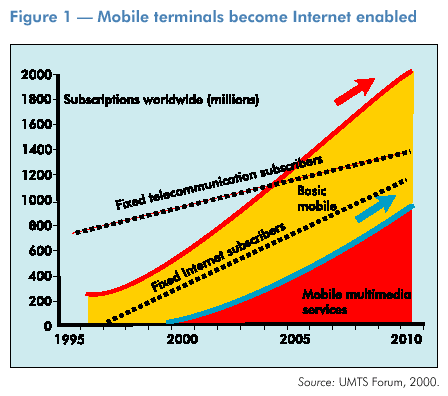
Fundamental changes have taken place in the requirements for international wireless telecommunication standards development and in the environment in which international standards are developed. First- and second-generation (1G and 2G) commercial wireless standards were developed by national and regional standards organizations. As a result, the first generation systems tended to be national in scope and therefore incompatible with each other.
The second-generation commercial wireless systems tended to be more regional in scope. For example, specifications for the Global System for Mobile (GSM) communications were initially developed by the European Telecommunication Standards Institute (ETSI) for the European region. Later, these GSM standards were "exported" to other regions of the world including Asia, Africa and North America. Similar statements can be made about the 2G standards developed in North America such as CDMA and TDMA. These standards were developed from a North American perspective, but were later "exported" to other regions of the world. It is important to note that new local variants were often added to these standards (for example, PDC is an Asian market variant of IS-54 TDMA).
Collaboration between ITU and external organizations
"There is no more local only market-place, global focus is the driver. The standards process for commercial wireless has changed forever", says Stephen Blust, Director of Technology Strategy and Standards at BellSouth Cellular Corporation and Chairman of ITU-R Working Party 8F*.
In order to meet the very aggressive timescales demanded by the rapidly growing global wireless telecommunications industry, ITU's Radiocommunication Sector (ITU-R) successfully developed and used a new model to standardize IMT-2000. This model involved the use of new cooperative electronic working methods between ITU and all the national and regional standards-development organizations which make up the global IMT-2000 standards team. These include: the Third Generation Partnership Project (3GPP), the Third -Generation Partnership Project 2 (3GPP2) and other industry representative groups (see Figure 2).

The 3GPP is made up of China Wireless Telecommunication Standard Group (CWTS), the Association of Radio Industries and Businesses (ARIB) and the Telecommunications Technology Committee (TTC) of Japan, the Telecommunications Technology Association (TTA) of the Republic of Korea, the Standards Committee T1 of the United States, and ETSI. The 3GPP2 was established by the United States' Telecommunications Industry Association (TIA) in collaboration with CWTS, ARIB, TTC and TTA to achieve international cooperation in the development of technical specifications based on CDMA2000.
"ITU has responded positively to these new international wireless specifications development organizations by creating a win-win atmosphere in which there is a role for all of the national and regional standards bodies", remarks Mr Blust.
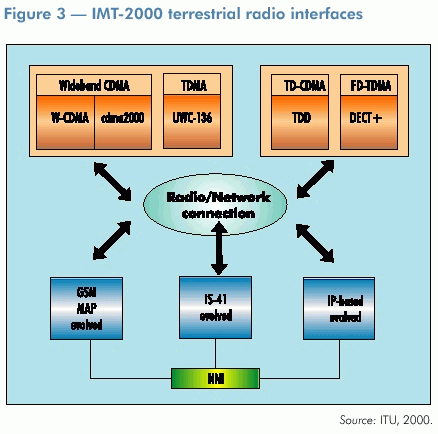
IMT-2000 standards development has, for many years, made full use of electronic working methods through a specially designed ITU website (www.itu.int/imt/). This approach was essential to the success of the development and evaluation stages of the radio specification process, where large amounts of documentation had to be rapidly circulated via the Internet to different groups around the world, allowing them to exchange and update these lengthy documents in real time.
|
* Working Party 8F is the successor to Task Group 8/1, which previously held primary responsibility for the development of IMT-2000 and completed its activities in November 1999 with the successful adoption of the first release of the IMT-2000 radio interface standard. |

The ITU Radiocommunication Assembly, held in Istanbul in May 2000, approved the detailed specifications of the radio interfaces for IMT-2000 in ITU-R Recommendation M.1457 (see Figure 3). This Recommendation may seem large, with its nearly 300 pages. But in reality, M.1457 is much larger than that because of the numerous references it contains to detailed specifications, which are available only in electronic form. The full text of M.1457 is readily accessible to ITU Members throughout the world via the ITU website (www.itu.int/itudoc/itu_r/rec/m/index.html).
Another major milestone in Istanbul was the approval by ITU's World Radiocommunication Conference (WRC-2000) of additional spectrum requirements for IMT-2000. With this approval, the stage is now set for the terrestrial component of 3G systems to operate in the common spectrum identified on a worldwide basis to meet projected growth. This common spectrum includes: 800/900 MHz, 1.7, 2 and 2.5 GHz.
In the Republic of Korea, bidders have been announced and licences are scheduled to be awarded by the end of 2000, with service to begin in time for the World Cup Football Games in June 2002
Furthermore, WRC-2000 decided that ITU-R should develop harmonized frequency arrangements which aim to achieve compatibility with existing frequency arrangements used by first- and second-generation systems. At the same time, studies on the future evolution of IMT-2000, including the provision of IP-based applications and the impact on spectrum resources, will be conducted by ITU-R in the next three years.
The successful results of Istanbul represent a real tribute to the exemplary preparatory technical work of ITU to identify spectrum requirements for IMT-2000 and candidate frequency bands for worldwide use. The same tribute must be paid to the efficient preparations carried out in the regions by organizations such as the Asia-Pacific Telecommunity (APT), the European Conference of Postal and Telecommunications Administrations (CEPT) and the Inter-American Telecommunication Commission (CITEL).
It is now important that regulators follow up on the commitments made by their governments at WRC-2000 and license the spectrum in the bands identified for IMT-2000 with great care, on the basis of expected demand by potential 3G operators in their countries. The spectrum identified for IMT-2000 is not prioritized and has no set timetable for use. The responsibility therefore falls on regulators to make sure that the situation of 1992 is not repeated where a sizeable 230 MHz of spectrum that had been globally identified for third-generation systems was auc tioned for a host of services, including PCS (personal communication services) in the Americas, somewhat complicating the situation of deploying IMT-2000 in those bands today.


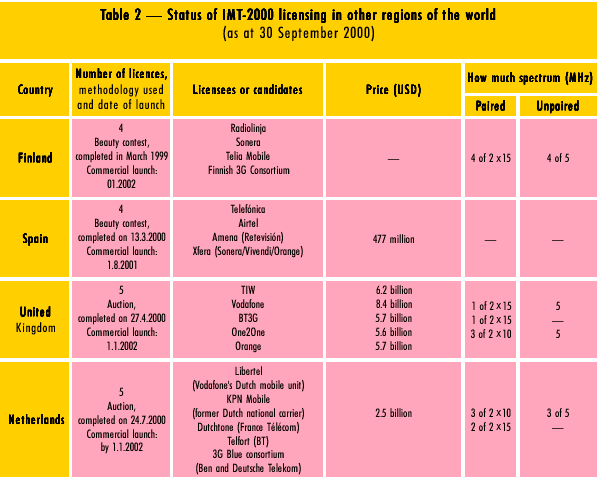
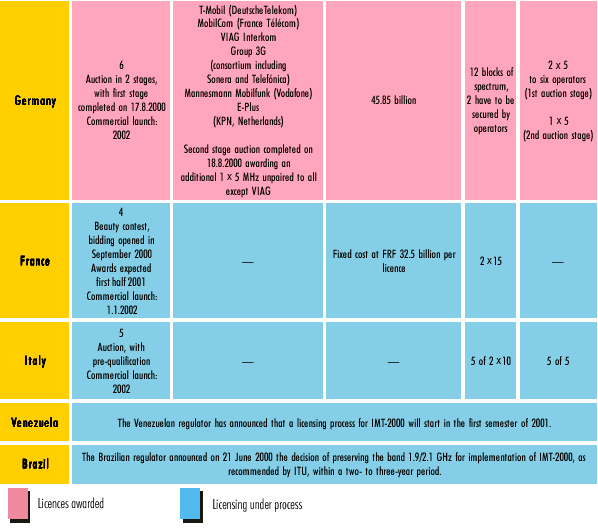
Licensing for 3G is being stimulated largely by the substantial progress made in ITU on system standards and frequency spectrum availability.
Tables 1 and 2 provide a non-exhaustive list of countries which have already licensed or will soon award licences for IMT-2000.
Following the early start made by Finland in 1999, Europe is now leading the licensing process with Spain, the United Kingdom, the Netherlands and Germany having already awarded licences to IMT-2000 operators, and many countries having called for bids or initiated the consultation phase.
Finland and Spain chose the method of comparative selection, often referred to as "beauty contest", for granting four licences each. In contrast, the United Kingdom, the Netherlands and Germany opted for auctioning the available spectrum in the 2 GHz IMT-2000 band and granted five to six licences to the winners of the auctions.
In the Asia-Pacific region, Thailand, the second country in the world to have issued IMT-2000 licences, awarded one licence and plans to award a second one later. In the Republic of Korea, bidders have been announced and licences are scheduled to be awarded by the end of 2000, with service to begin in time for the World Cup Football Games in June 2002.
Japan has awarded 11 regional licences to three mobile operators per region and plans to be the first country in the world to launch commercial IMT-2000 services. ITU analysts say that Japan's early experience and success with its proprietary i-mode system should give its vendors and service providers an advantage when the global 3G standard networks are introduced. NTT DoCoMo intends to be the first operator to launch 3G. It was granted an IMT-2000 licence in June 2000 and plans to start service in May 2001, some seven months earlier than the target date established by the European Union.
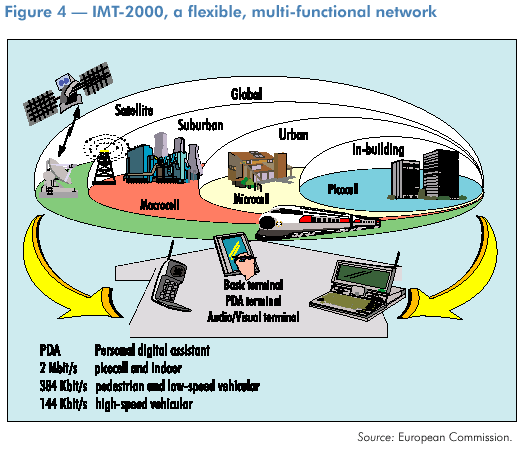
Other Asia-Pacific economies are at different stages in the IMT-2000 licensing process (see Table 1). New Zealand was in the midst of a spectrum auction in September 2000. New Zealand and Australia are the only two sure bets to use auctions as the way of awarding licences. Most of the remaining economies are leaning towards the so-called beauty contest which does not earn the government as much money as an auction but gives it more control over who wins the licences, allowing governments to favour domestic companies. Indeed, there is a perception that in most economies, existing mobile operators will be granted 3G licences. In the Republic of Korea, operators are already experimenting with 3G technologies before the government has even awarded licences. Most developing countries in the region have not yet announced 3G licensing plans.
In the Americas, Venezuela was the first country to announce plans to issue IMT-2000 licences for the beginning of 2001. This is pushing the other four countries of the Andean community (Colombia, Peru, Ecuador, and Bolivia) to follow the same track and multilateral studies are being conducted to come up soon with a sub-regional agreement for a coordinated implementation of IMT-2000. It is also worth mentioning the decision by Brazil to reserve the 2 GHz IMT-2000 spectrum for near future implementation.

The UMTS Forum Chairman, Bernd Eylert, drew comparisons with the success of the Japanese i-mode mobile Internet service that has already attracted over 10 million customers. "Only three years ago, mobile multimedia was an industry vision — now it is becoming a reality." Furthermore, he noted that the high sums raised in the German and United Kingdom auctions (see Table 2) may accelerate the roll-out of 3G networks rather than delay them. "With an investment of this scale, operators will be focused on generating the swiftest possible return", Mr Eylert stated, adding that "with Japan already committed to launching services as soon as 2001: we can be sure that Europe will not be far behind".
With the world's largest mobile market and the first planned launch of 3G networks, the Asia-Pacific region is poised to become a mobile powerhouse. The trick will be to translate these advantages by using mobile to enhance communication availability to the millions of the region's inhabitants that currently have no access.
As IMT-2000 has been conceived from the ground up as a system to meet the real needs of users globally, and as the licensing process accelerates across the different regions of the world, the next challenge is to refine standards that will deliver the vision of affordable access to wireless multimedia services for mobile users everywhere (see Figure 4). Above all, this work must mirror the real needs and constraints of the market-place. The current collaborative partnership is expected to make a significant contribution to hastening the global success of IMT-2000 systems.
Mr Blust says that going forward into systems beyond 3G, the standards community must start with an international perspective in all aspects: from market-place requirements to the technology development cycle, including considerations of common global frequency bands and uniform international regulations. Having an international perspective at the start is important from the viewpoint of end users, service providers, and manufacturers.

ITU-R is currently developing a framework for the orderly growth and ongoing technology deployment. The emphasis of work will be on developing enhancements for IMT-2000 systems and beyond (see Figure 5).
Some of the enhancements that are expected include: higher speeds (more than 10 Mbit/s), greater spectral efficiencies, use of a common frequency band worldwide and moving from a circuit-switched domain to a packet-switched domain. For radio access, improvements will include: adaptive antennas, software-defined radio, multi-user detection, multiple access techniques, as well as better compression techniques, better quality of service, better CODECS, higher capacity, interference mitigation techniques and innovative services.

According to Mr Blust, we should view the future standards landscape for IMT-2000 as four sides of a pyramid: market-place, spectrum, regulatory, and technology. "Moving from the base to the tip on each of the four sides provides a national to regional to international perspective. The common meeting point for three of these four faces of the pyramid is the ITU. The three interrelated factors that come together globally only at the ITU are the spectrum (the natural resource of wireless), the regulatory (the authorization to use the natural resource), and the technology (the mechanism to put the natural resource to work)", Mr Blust explains.
With regard to the market-place and technology, IMT-2000 standards must be evolved in an efficient manner such that the rapidly changing needs of the market-place are met in both the near term and throughout the longer term future vision.
The timetable for this process will be driven by market considerations and technology advances. Two of the most important roles of ITU-R are: to provide a global forum to support this process and to continue to extend the IMT-2000 vision to ensure that the goals of harmonization, convergence and reduction in the number of technology options are retained.
"A major driver is that development of very complex systems with severe time to market challenges can no longer be completed by any single organization, entity or company. The ITU has fundamentally altered the standards landscape in pioneering this collaborative solution. This foundation and intermeshing of factors is the cornerstone of the future advancements of IMT-2000. Working Party 8F is committed to the vision of IMT and the development of the requisite requirements and standards needed as that future vision leaps towards reality. The international community as users of these standards expect and deserve nothing less", concludes Mr Blust.